-
Countries
-
Data and Analysis
-
Special Focus
-
Crisis Responses

Contact
DTM Nigeria, AllUsersInDTMNigeria@iom.int
Language
English
Location
Nigeria
Period Covered
Mar 05 2022
Mar 11 2022
Activity
- Mobility Tracking
- Baseline Assessment
- Points of Entry (PoE)
During the COVID-19 pandemic, IOM's Displacement Tracking Matrix (DTM), in collaboration with the World Health Organization (WHO), monitors cross-border movements to and from Nigeria's Borno State in north-east Nigeria. Assessments are conducted at Points of Entry located along the border with Cameroon.
During the period 05 - 11 March 2022, 155 movements were observed at three Points of Entry in Borno state. Of the total movements recorded, 82 were incoming movements. The incoming movements included 76 persons from the Far North Region in Cameroon, one person from N’djamena in the Republic of Chad and 5 persons from Bol in the Republic of Chad. Additonally, a total of 73 outgoing movements were recorded from Borno State towards the Far North Region of Cameroon.
A range of data was collected during the assessments to better inform on travellers’ nationalities, sex, reasons for moving, mode of transportation and timeline of movement as shown in figures 1 to 4 below:
Contact
DTM Yemen, iomyemendtm@iom.int
Location
Yemen
Activity
- Event Tracking
- Mobility Tracking
Period Covered
Mar 06 2022 -Mar 12 2022
From 01 January 2022 to 12 March 2022, IOM Yemen DTM estimates that 4,279 households (HH) (25,674 Individuals) have experienced displacement at least once.
Since the beginning of 2022, DTM also identified 011 displaced households who left their locations of displacement and either moved back to their place of origin or another location.
Between 06 and 12 March 2022, IOM Yemen DTM tracked 253 households (1,518 individuals) displaced at least once. The majority of people moved into/within the following governorates and districts:
• Al Hodeidah (92 HH) – Hays (91 HH), Al Khukhah (1 HH) districts. Most displacements in the governorate were internal.
• Abyan (79 HH) – Khanfar (65 HH), Zinjibar (14 HH) districts. Most displacements in the governorate originated from Al Hodeidah.
• Marib (27 HH) – Marib City (16 HH), Marib (11 HH) districts. Most displacements in the governorate originated from Ibb and Al Hodeidah.
The majority of people moved from the following governorates and districts
• Al Hodeidah (164 HH) – Hays (98 HH), Zabid (20 HH), Al Jarrahi (18 HH) districts.
• Taiz (22 HH) – Jabal Habashi (4 HH), Maqbanah (4 HH), Hayfan (3 HH) districts.
• Ad Dali (17 HH) – Qatabah (17 HH) district.
Population Groups
Survey Methodology
Unit of Analysis Or Observation
Type of Survey or Assessment
Keywords
Geographical Scope
Administrative boundaries with available data
The current dataset covers the following administrative boundaries
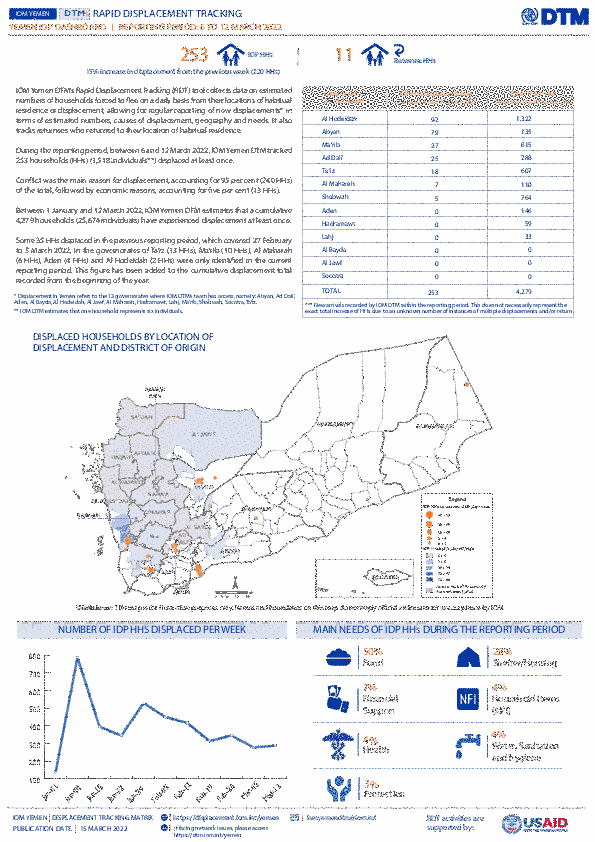
Contact
DTM Yemen, iomyemendtm@iom.int
Language
English
Location
Yemen
Period Covered
Mar 06 2022
Mar 12 2022
Activity
- Rapid Emergency Registration
- Mobility Tracking
IOM Yemen DTM’s Rapid Displacement Tracking (RDT) tool collects data on estimated numbers of households forced to flee on a daily basis from their locations of origin or displacement, allowing for regular reporting of new displacements in terms of estimated numbers, geography, and needs. It also tracks Returnees who returned to their location of origin.
From 01 January 2022 to 12 March 2022, IOM Yemen DTM estimates that 4,279 households (HH) (25,674 Individuals) have experienced displacement at least once.
Since the beginning of 2022, DTM also identified 011 displaced households who left their locations of displacement and either moved back to their place of origin or another location.
Between 06 and 12 March 2022, IOM Yemen DTM tracked 253 households (1,518 individuals) displaced at least once. The majority of people moved into/within the following governorates and districts:
- Al Hodeidah (92 HH) – Hays (91 HH), Al Khukhah (1 HH) districts. Most displacements in the governorate were internal.
- Abyan (79 HH) – Khanfar (65 HH), Zinjibar (14 HH) districts. Most displacements in the governorate originated from Al Hodeidah.
- Marib (27 HH) – Marib City (16 HH), Marib (11 HH) districts. Most displacements in the governorate originated from Ibb and Al Hodeidah.
The majority of people moved from the following governorates and districts
- Al Hodeidah (164 HH) – Hays (98 HH), Zabid (20 HH), Al Jarrahi (18 HH) districts.
- Taiz (22 HH) – Jabal Habashi (4 HH), Maqbanah (4 HH), Hayfan (3 HH) districts.
- Ad Dali (17 HH) – Qatabah (17 HH) district.
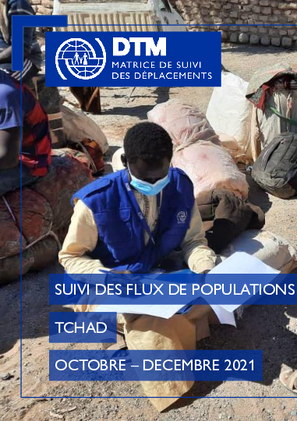
Contact
DTM Tchad, dtmtchad@iom.int
Language
French
Location
Chad
Period Covered
Oct 01 2021
Dec 31 2021
Activity
- Flow Monitoring
Afin de mieux comprendre les mouvements et tendances migratoires en Afrique de l’Ouest et du Centre, l’OIM, à travers la Matrice de suivi des déplacements (Displacement Tracking Matrix, DTM), met en œuvre l’activité de Suivi des flux de populations (Flow Monitoring, FM). Le suivi des flux, mis en œuvre en étroite collaboration avec les autorités et des partenaires nationaux et locaux, est composé de deux outils: l’enregistrement des flux (Flow Monitoring Registry, FMR) et les enquêtes individuelles (Flow Monitoring Survey, FMS). Il récolte des données clés sur les flux migratoires, les profils des voyageurs et les parcours et intentions des migrants, afin de fournir une meilleure compréhension des flux migratoires dans la région et contribuer à l’élaboration des politiques migratoires basées sur des évidences.
À cet effet, plusieurs points de suivi des flux de population (Flow Monitoring Point, FMP) sont installés dans des zones de transit importantes. Durant le quatrième trimestre de 2021, trois FMP ont été actifs : Faya (FMP situé dans la province du Borkou au nord du Tchad); Ounianga Kébir (province de l’Ennedi Ouest au nord du Tchad) et Sido (province du Moyen-Chari au sud du Tchad). Ce rapport présente donc les données clés collectées entre octobre et décembre 2021 au niveau de ces trois FMP.
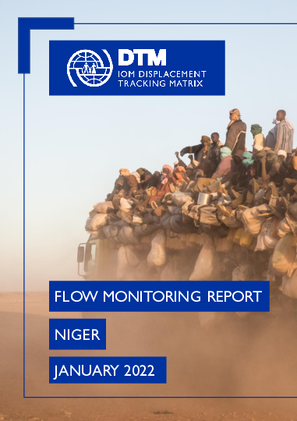
Contact
DTM Niger, DTMNiger@iom.int
Language
English
Location
Niger
Period Covered
Jan 01 2022
Jan 31 2022
Activity
- Flow Monitoring Survey
- Flow Monitoring
In order to better understand migratory movements and trends in West and Central Africa, IOM, through the Displacement Tracking Matrix (DTM), implements the activity of monitoring flows of populations (Flow Monitoring, FM). In Niger, the DTM collects data at 7 Flow Monitoring Points (FMPs), in order to identify areas with high cross-border and intra-regional mobility and collect data on mobility trends and profiles. and journey of travellers in the country. This report presents the data obtasined through the flow recording activities in January 2022, at the level of the seven FMPs installed in Niger.

Contact
DTM Mozambique, DTMMozambique@iom.int
Language
English
Location
Mozambique
Period Covered
Mar 13 2022
Mar 14 2022
Activity
- Other
Cyclone Gombe made landfall as a Category 3 Tropical Cyclone on Friday, March 11 at 00:00 GMT on the coast between Mossuril and Mogincual districts (Nampula Province). The most hit provinces are Nampula (districts: Angoche, Moma, Mogovolas, Mucuburi, Monapo, Ilha, Lalaua, Mossuril, Nacala Porto and Meconta) and Zambezia (districts: Namacurra, Gile, Nicoadala, Maganja, Pebane, Molocue, Mocubela, Mopeia, Mocuba and lle), leaving many houses and power lines destroyed with an estimated affected population of 116,454 individuals. Initial assessments have recorded 4,929 households hosted in 12 temporary accomadations in Nampula. Where accessible, data collection teams support continued assessments across 3 identified Accommodation Centers hosting families displaced across Nicoadala district (Zambezia).
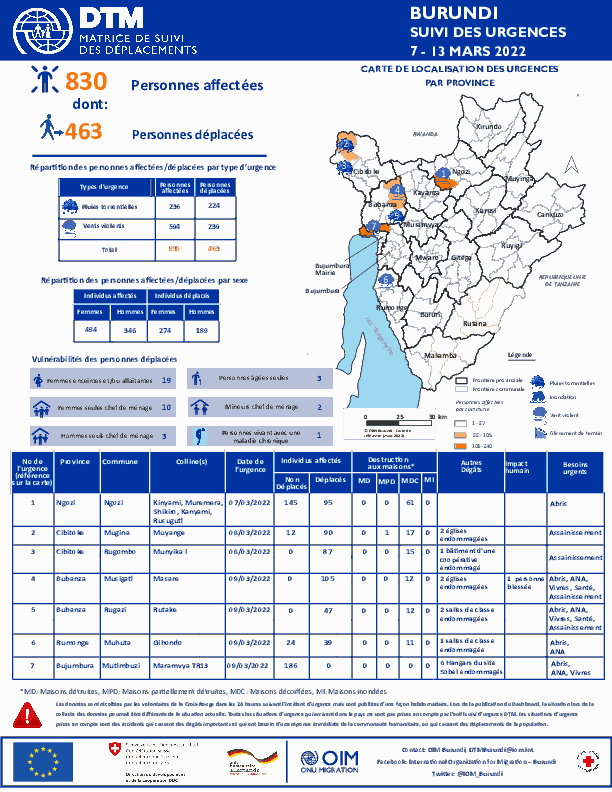
Contact
DTM Burundi, DTMBurundi@iom.int
Language
French
Location
Burundi
Period Covered
Mar 07 2022
Mar 13 2022
Activity
- Event Tracking
- Mobility Tracking
Entre le 7 et le 13 mars 2022, la DTM a identifié 830 personnes affectées, dont 463 personnes déplacées, par les pluies torrentielles et les vents violents dans les provinces de Bubanza, Bujumbura, Cibitoke, Ngozi et Rumonge.

Contact
DTM Sudan; dtmsudan@iom.int
Language
English
Location
Sudan
Snapshot Date
Mar 10 2022
Activity
- Event Tracking
- Mobility Tracking
The DTM Emergency Event Tracking (EET) is deployed to track sudden displacement and population movements, provide more frequent updates on the scale of displacement, and quantify the affected population when needed. As a subcomponent of the new Mobility Tracking methodology in Sudan (Round Three), and activated on a need basis, EET utilises a broad network of key informants to capture best estimates of the affected population presence per location – a useful tool for humanitarian response planning and design.
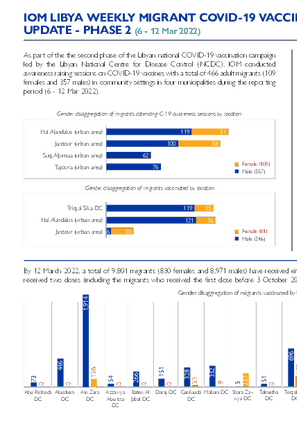
Contact
DTM Libya, DTMLibyateam@iom.int
Language
English
Location
Libya
Period Covered
Mar 06 2022
Mar 12 2022
Activity
- Other
As part of the the second phase of the Libyan national COVID-19 vaccination campaign led by the Libyan National Centre for Disease Control (NCDC), IOM conducted awareness raising sessions on COVID-19 vaccines with a total of 466 adult migrants (109 females and 357 males) in community settings in four municipalities during the reporting period (6 - 12 Mar 2022).

Contact
DTM Mali, DTMMali@iom.int
Language
French
Location
Mali
Period Covered
Oct 01 2021
Dec 31 2021
Activity
- Survey
- Flow Monitoring Survey
- Flow Monitoring
Le rapport présente les principaux résultats des enquêtes individuelles effectuées par la DTM auprès de migrants transitant par les points de suivi de flux (FMP) du Mali au cours du dernier trimestre de l’année 2021.
Les résultats des enquêtes FMS réalisées témoignent du fait que le Mali soit l’une des principales routes empruntées par les migrants en Afrique de l’Ouest. En effet, la diversité des nationalités observées (19 nationalités), des routes empruntées, des pays de provenance et de destination, démontrent la place prépondérante qu’occupe le Mali dans les mobilités en Afrique de l’Ouest et du Centre.
Il ressort par ailleurs de ces analyses que les migrants sont majoritairement des hommes célibataires, des jeunes âgés entre 20 et 30 ans voyageant principalement pour des raisons économiques. Spécifiquement, ils sont à la recherche d’opportunités de travail soit à l’intérieur de la région, soit en Afrique du Nord ou espérant rejoindre l’Europe.
